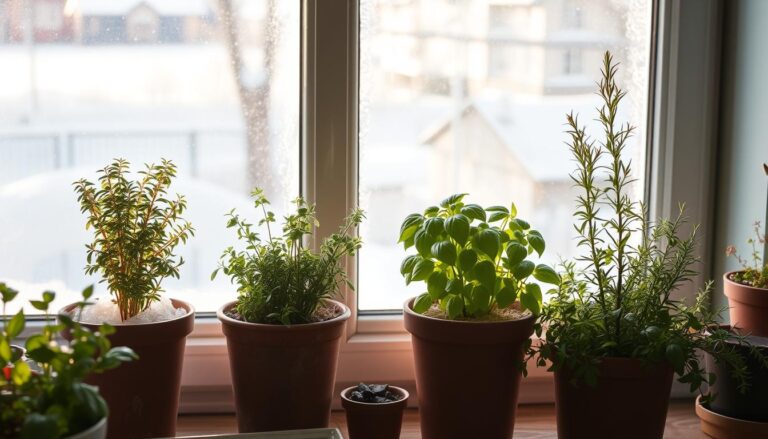10 Easy Indoor Herbs To Start Your Indoor Herb Garden (No Green Thumb Required!)

Introduction
Starting an indoor herb garden as a home gardener is a simple and rewarding way to bring fresh flavours into your cooking without ever leaving the house. Imagine snipping fresh mint for your chai or adding a handful of coriander to a curry—all from plants growing right in your kitchen! Indoor herb gardening doesn’t need much space, and it’s perfect for beginners because you can start with a few easy-to-grow herbs.
In this post, we’ll cover ten herbs that are perfect for getting started with indoor gardening. With a bit of light, water, and basic care, you’ll have fresh herbs at your fingertips in no time. Let’s dive in and see how you can create your own little indoor herb garden!
Benefits of Growing Herbs Indoors

Having an indoor herb garden has so many benefits, especially if you enjoy cooking with fresh ingredients. Growing herbs indoors means you always have fresh flavours right in your kitchen—no need to run to the market for a little bit of dhania or basil. Plus, it’s a cost-effective way to enjoy fresh ingredients without spending too much.
An indoor herb garden is also very easy to manage. Herbs don’t need a lot of care, just a little light and water, and they’ll keep growing happily. And let’s not forget how nice it is to have some greenery at home! Whether you’re in a small apartment or a bigger house, these little plants add a lovely, natural touch to your space.
So, with an indoor herb garden, you get convenience, fresh flavours, and a bit of nature—all without much work. Let’s look at the best herbs to start with!
Top 10 Easy Indoor Herb plants for Beginners

If you’re new to growing herbs indoors, don’t worry—it’s easier than you think! These ten herbs are great for beginners because they don’t need too much care and grow well indoors. All you need is a bit of sunlight, some water, and basic attention to keep them happy. Here’s a closer look at each herb, along with some simple tips for taking care of them.
1. Basil
- Description: Basil has a nice aroma and a slightly sweet taste. It’s used in many dishes, from Italian to Indian.
- Care: Basil needs bright, indirect sunlight. Keep the soil slightly moist, but don’t let it get too wet.
- Uses: Perfect for pasta, salads, or even adding a twist to chutneys.
2. Mint (Pudina)
- Description: Mint is refreshing and grows quickly, making it a good choice for beginners.
- Care: Mint does well in moderate sunlight. It grows fast, so it’s best to keep it in a separate pot. Water regularly to keep the soil moist.
- Uses: Great for drinks like chai and lemonade, or for making chutneys.
3. Parsley
- Description: Parsley has a mild, fresh taste and is a popular garnish in many dishes.
- Care: Parsley needs some light but can handle lower light better than other herbs. Keep the soil evenly moist.
- Uses: Ideal as a garnish and adds a nice flavour to soups, salads, and pasta.
4. Coriander (Dhania)
- Description: Dhania is a must-have in Indian kitchens with its unique flavour and aroma.
- Care: Coriander needs bright, indirect light and moist soil. Just water enough to keep it from drying out, but don’t soak it.
- Uses: Essential in salads, curries, and as a garnish for many dishes.
5. Chives
- Description: Chives have a mild onion flavour and are great for adding a little extra taste.
- Care: Chives need bright light, so put them near a sunny window if possible. Water when the soil feels dry on top.
- Uses: Perfect for soups, dips, and as a topping for salads and pasta.
6. Thyme
- Description: Thyme has a strong, earthy taste, commonly used in both Indian and Western cooking.
- Care: Thyme needs bright light and prefers soil that dries out a little between waterings. Be careful not to overwater it.
- Uses: Adds depth to roasted dishes and soups and pairs well with meats and vegetables.
7. Oregano
- Description: Oregano has an earthy, slightly bitter taste and is great for Italian dishes.
- Care: Oregano loves bright light. Water only when the soil starts to feel dry on top.
- Uses: Ideal for pizzas, pastas, and any dishes with tomatoes and cheese.
8. Rosemary
- Description: Rosemary has a unique aroma with needle-like leaves and adds a lot of flavour.
- Care: This herb likes bright, indirect light and soil that dries out between waterings. Don’t water too often.
- Uses: Perfect for roasted potatoes, meats, and even breads.
9. Sage
- Description: Sage has a strong, peppery flavour, and its soft, fuzzy leaves make it look unique.
- Care: Sage likes bright, indirect light and should be watered sparingly. Let the soil dry out a bit between waterings.
- Uses: Pairs well with stuffing, vegetables, and savoury dishes.
10. Lemon Balm
- Description: Lemon balm has a refreshing, citrussy smell and taste.
- Care: It does best in moderate sunlight and needs regular watering to keep the soil slightly moist.
- Uses: Perfect for teas, desserts, and as a garnish for cold drinks.
These ten herbs are easy to grow indoors and add fresh flavours to any meal. Each one has its own taste and can be used in different dishes. Start with a few that sound good to you, and before you know it, you’ll have fresh herbs growing right in your kitchen!
Indoor Herb Garden Setup Tips

Setting up an indoor herb garden is simple once you know the basics. With just a few items and the right spot, you can give your herbs the perfect growing conditions to grow well. Here are some easy tips to help you get started.
1. Choosing the Right Pots
The pots you pick make a big difference. Herbs don’t like water sitting around their roots, so it’s best to choose pots with holes at the bottom for good drainage. Terracotta or clay pots work well because they let the soil breathe, but you can use any container you like—just make sure to add holes if it doesn’t have any. Even an old mug or small bucket can work!
2. Selecting the Right Soil
Herbs grow best in well-drained soil. A regular potting mix is good, or you can make your own by mixing garden soil with some coco peat and compost. This mix will hold enough water without making the soil too wet, which is exactly what herbs need. Try to avoid heavy soils that hold water, as that can lead to root problems.
3. Finding the Best Spot for Light
Most herbs need 4-6 hours of sunlight each day, so a sunny window is the perfect spot. South-facing windows are ideal since they get the most light. If you don’t get much sunlight indoors, you can use an LED grow light to help your herbs. Just place it above the plants for a few hours daily. Remember to rotate the pots every few days so all sides get light and grow evenly.
4. Watering Properly
Watering sounds simple, but indoor herbs need just the right amount. It’s best to water only when the top layer of soil feels dry to the touch. Herbs don’t like sitting in water, so pour slowly and let the water drain out from the bottom. If water collects in the saucer, empty it to keep the roots from getting soggy.
5. Giving Enough Space
Herbs don’t need a lot of space, but avoid crowding them together too closely. It’s best to give each plant its own pot so the roots have space to grow, and you can take care of each herb separately. If you’re low on space, stackable or vertical planters can help you fit more plants in a small area.
6. Managing Humidity and Airflow
Indoor air can get a bit dry, especially if there’s an AC running. Herbs like basil and mint enjoy some moisture, so misting them with water every few days can help. Grouping the plants together also helps them retain moisture. And don’t forget, herbs need fresh air too. If you can, open a window nearby once in a while to let some air in and keep them healthy.
With these simple setup tips, your indoor herb garden will be off to a great start. A bit of planning goes a long way in keeping your herbs happy and growing well!
Conclusion
Starting an indoor herb garden is easy and brings so many benefits. Just imagine having fresh mint for your chai or coriander for your curry—all right in your kitchen! By starting with these simple, low-maintenance herbs, you’ll see how fun and relaxing indoor gardening can be.
With a bit of regular care, your herbs will grow nicely, giving you fresh flavours whenever you need them. Indoor herb gardening doesn’t need much space or effort, but it adds a lovely green touch to any room. So, pick a few herbs to start, and enjoy having fresh, homegrown herbs at your fingertips every day!
FAQs
1. Which are the easiest herbs to grow indoors for beginners?
Answer: Basil, mint, coriander and parsley are great to start with. They’re low-maintenance and grow well indoors without much fuss.
2. How much sunlight do indoor herbs need?
Answer: Most herbs need about 4-6 hours of sunlight each day. A sunny window is perfect. If there’s not much sunlight, an LED grow light can help.
3. Can I use any container for indoor herbs?
Answer: Yes, you can use almost any container, but make sure it has drainage holes at the bottom. This helps get rid of extra water and keeps the roots healthy.
4. How often should I water my indoor herbs?
Answer: It depends on the herb, but a good rule is to water when the top of the soil feels dry. Herbs like basil and coriander like more moisture, while rosemary and thyme are fine if the soil dries a bit between waterings.
5. Do indoor herbs need fertiliser?
Answer: Indoor herbs don’t need much fertiliser. A small amount of organic fertiliser once a month can help them grow well, but don’t overdo it.






